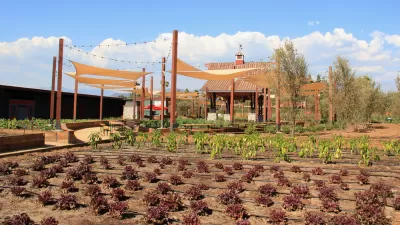Hydroponic indoor farmers hope to charge a premium for plants grown out of season in indoor farms. The notion has generated attention from big investors, but whether or not consumers will follow is an open question.

Is an indoor hydroponic farming boom coming? These farms use plenty of energy and make produce that is currently a lot more expensive than conventionally grown crops, but some think the appeal of out-of-season produce will be worth the cost. "Last year when San Francisco-based indoor farming startup Plenty, which grows a variety of salad and leafy greens hydroponically (without soil) and uses artificial lighting in facilities in three locations, announced that it had raised a whopping $200 million in funding from the SoftBank Vision Fund, whose investors include Amazon founder Jeff Bezos," Steve Holt writes for Civil Eats. These farms grow much more produce per acre than traditional farms.
"The astronomical capital costs associated with starting a large hydroponic farm (compared to field and greenhouse farming), its reliance on investor capital and yet-to-be-developed technology, and challenges around energy efficiency and environmental impact make vertical farming anything but a sure bet," Holt writes.
Another barrier to growth may be consumer perception of produce grown hydroponically. A University of Illinois study looked into the question. "They asked a panel of 117 participants a series of questions about their perceptions of and willingness to pay for lettuce grown in fields, greenhouses, and in vertical farms. While vertical farming ranked fairly high in terms of produce quality and safety, the tech-heavy production method was rated less 'natural' than both field farming and greenhouse and ranked last in participants’ willingness to purchase it," Holt reports.
FULL STORY: Can Vertical Farms Reap Their Harvest? It’s Anyone’s Bet.

Montreal Mall to Become 6,000 Housing Units
Place Versailles will be transformed into a mixed-use complex over the next 25 years.

Planetizen Federal Action Tracker
A weekly monitor of how Trump’s orders and actions are impacting planners and planning in America.

DARTSpace Platform Streamlines Dallas TOD Application Process
The Dallas transit agency hopes a shorter permitting timeline will boost transit-oriented development around rail stations.

Interactive Map Reveals America's “Shade Deserts”
Launched by UCLA and American Forests to combat heat-related deaths, the tool maps the shade infrastructure for over 360 U.S. cities.

Bicycles and Books — In Sacramento, Libraries Now Offer Both
Adult library card holders can check out e-bikes and e-trikes for up to one week.

Colorado Landfills Emit as Much Pollution as 1M Cars
Landfills are the third-largest source of methane pollution in Colorado, after agriculture and fossil fuel extraction.
Urban Design for Planners 1: Software Tools
This six-course series explores essential urban design concepts using open source software and equips planners with the tools they need to participate fully in the urban design process.
Planning for Universal Design
Learn the tools for implementing Universal Design in planning regulations.
City of Mt Shasta
City of Camden Redevelopment Agency
City of Astoria
Transportation Research & Education Center (TREC) at Portland State University
City of Camden Redevelopment Agency
Municipality of Princeton (NJ)
Regional Transportation Commission of Southern Nevada



























